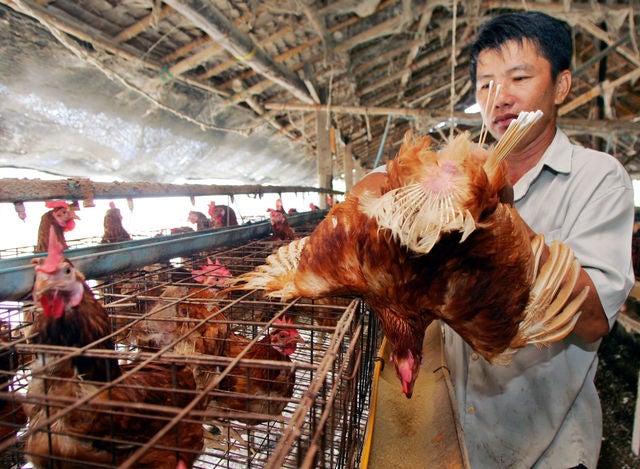The newest disease detectives: Farmers
As health leaders build surveillance systems to prevent pandemics, farmers find themselves on the front lines

To prevent the next pandemic, scientists, public health officials, and researchers around the world are deputizing farmers to serve as frontline disease detectives.
Given that three out of four emerging infectious diseases start in animals, farmers, who in many geographies live in close proximity to their animals, are uniquely positioned to notice suspicious zoonotic infections early, before they can spread to and sicken humans.
Zoonotic diseases – which start in animals and then spillover into humans – have sparked deadly epidemics in humans repeatedly over the past two decades. COVID-19 is only the most recent, deadly potential example, with scientists still working to pinpoint its origin. Before COVID there was Severe Acute Respiratory Syndrome (SARS), which was transmitted to humans from palm civets; Middle East Respiratory Syndrome (MERS), which was transmitted to humans from camels; the aptly named Avian flu and Swine flu; HIV, which originated in chimpanzees; and Ebola, which originated in primates.
As human populations continue to grow, pushing farms and human settlements further into wild animal habitats, the risk of diseases jumping from animals to humans only increases.
To counter this growing threat, researchers, scientists, and health officials are developing, expanding, and strengthening surveillance tools and initiatives to detect zoonotic disease early enough to prevent the next pandemic. Often, their initiatives rely on those closest to animals: farmers and pastoralists.
“There is nothing inevitable about a pandemic. If you prepare, the pandemics simply won’t happen,” said Wendy L. Schultz-Henry, President & CEO of InSTEDD, which develops technologies related to pandemic preparedness.
Consider Thailand’s Participatory One Health Disease Detection (PODD) project which relies on more than 19,000 farmers to serve as the vanguard of the country’s defense. PODD educates farmers, who often live above or immediately adjacent to their animal pens, about animal diseases and encourages them to report any sickness in animals through a simple smartphone app. Their reports are triaged by analysts and routed to public health and livestock health officials who lead diagnostic and containment measures. In 2015, just one year after launch, farmers used PODD to alert authorities to an outbreak of foot-and-mouth disease, allowing officials to contain the disease and saving $4 million in potential livestock losses.
“What makes PODD particularly effective, is that we incentivize farmers to report cases,” said Patipat Susumpow co-founder of PODD. “Not only to keep their community safe, but when they report cases and a response team is sent to investigate, the farmer receives veterinary care and medicine for their livestock.”
This incentive structure, that aligns pandemic prevention with farmers’ interests, has helped make PODD a win-win-win for farmers, communities, and health officials. It is particularly important in low- and middle-income countries, such as Thailand where 40 percent of farming households live below the poverty line. PODD enables farming families to detect small-scale outbreaks and contain the spread before all of their livestock or all of their community’s livestock needs to be culled – plunging them deeper into poverty.
PODD’s success has prompted Tanzania to adapt and launch a similar tool among the Masaai pastoralist communities. Dubbed AfyaData, the app is being piloted with 700 users in two districts and early results are promising. Already, it has logged 8,000 cases of animal health concerns and more than 4,800 cases of human health concerns. Cambodia, Laos, Indonesia, Vietnam, India, and Uganda are currently developing their own programs modelled on PODD.
Cambodia has launched a hotline that similarly crowd-sources cases of suspected unusual animal or human illness. Pre-pandemic, the “115 hotline” was receiving about 500 calls a day and helped identify hundreds of cases of animal and human disease. During the pandemic, the hotline quickly became the primary means of reporting suspected cases of COVID and went from receiving 500 to 18,000 daily calls.
“This was an extremely valuable tool during the pandemic, said Channé Suy Lan, Managing Director of InSTEDD iLab Southeast Asia. “Imagine those thousands of people crowding into health clinics to be tested. Instead, the hotline helped determine who needed to be tested.”
To accommodate the higher volume of calls, the Cambodian CDC has increased staffing for the hotline. The Ministry of Health has also adapted the 115 hotline to perform robocalls to support contact tracing efforts.
Each of these tools pre-dates COVID-19. But because they were designed to be flexible, they have been able to pivot to support efforts to contain COVID-19. Both PODD and AfyaData, originally designed with a singular focus on animal health, are now also being used to pinpoint and track the spread of COVID among humans and can be adapted to support the next health emergency.
“All of these innovations demonstrate how disease surveillance tools developed before a crisis can be utilized and ramped up during a crisis,” said Nomita Divi, Director of Ending Pandemics. “These countries and partners had the foresight to develop these flexible tools, now other countries can benefit, especially because these are all open-source tools and can be adapted to other circumstances and needs.”
These tools support the sort of public cooperation that is critical for pandemic preparedness, said Suy Lan of InSTEDD iLab Southeast Asia. “115 is an example of how we can give the public the opportunity to cooperate in an important way,” said Suy Lan. “Preventing pandemics is about human cooperation.”
